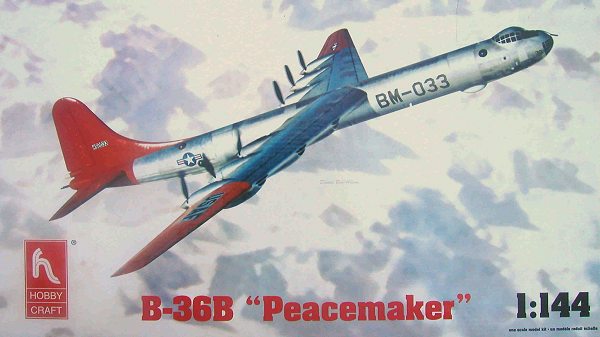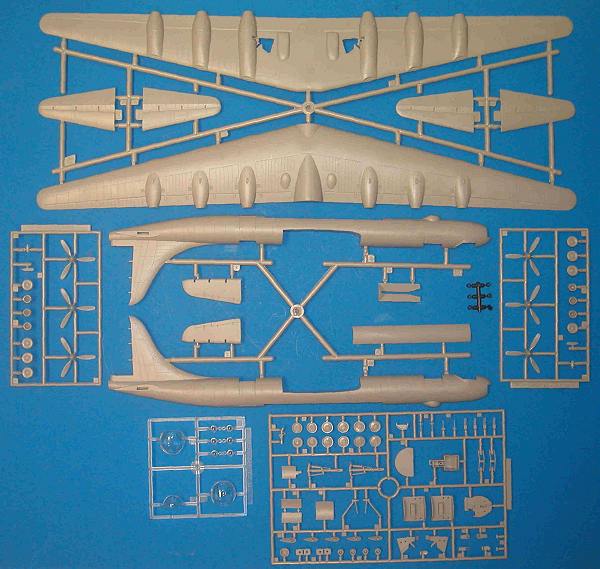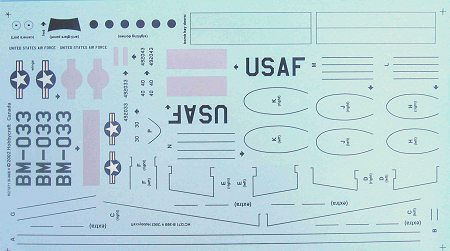
|
KIT: |
Hobbycraft 1/144 B-36B Peacemaker |
|
KIT # |
1271 |
|
PRICE: |
$39.95 |
|
DECALS: |
Two aircraft |
|
REVIEWER: |
|
|
NOTES: |

|
HISTORY |
“Peacemaker.” “Big Stick.” “Magnesium Overcast.” Whatever reporters and PR types called it, the Convair B-36 was the quintessential symbol of America’s air might in the early years of the Cold War. Never mind that the biggest bomber ever to serve with the U.S. Air Force was a piston-engined dinosaur in the rapidly evolving Jet Age, or that even many Air Force generals questioned the need for it. The B-36 was the only plane at the time capable of carrying the hulking nuclear weapons of the era from U.S. bases to the homeland of the Red Menace.
The first combat-ready model was the B-36B. According to the U.S. Air Force Museum’s website, the “B” became operational at Carswell AFB, Texas in 1948 with the 7th Bomb Group. On December 7-8, 1948, a B-36B flew a round-trip practice mission between Carswell and Hawaii. The aircraft averaged 228 mph during the 35 hour-plus flight.
Like most Air Force aircraft, the B-36 received upgrades during its service life. Most important was the addition of four General Electric J47 jet engines to the aircraft’s six Pratt & Whitney R-4360 piston powerplants. In its “RB” designation, the B-36 served as a strategic reconnaissance platform, trading nukes for a battery of cameras and flash bombs.
The Air Force also conducted several novel experiments using the B-36. In the FICON project, the Peacemaker flew as a mother ship for specially modified RF-84F fighters in an attempt to extend the range of the smaller planes. With a similar goal, Project Tom Tom coupled RF-84Fs to the wingtips of a B-36. One aircraft was even used for tests of an airborne nuclear reactor (albeit not for propulsion) in the mid-1950s.
Many of us who have reached a certain age became enamored with the B-36 thanks to the 1955 movie “Strategic Air Command,” starring screen star/Air Force Reserve pilot Jimmy Stewart. Stewart played an aging pro baseball player recalled to active duty, despite his serious misgivings, as a light colonel with SAC. The wing he is assigned to flies late-model B-36s for most of the film. Eventually, of course, he realizes how vital it is that pilots with his experience return and help SAC deter the evildoers plotting the demise of the American Way of Life from their Kremlin inner sanctum.
But as a 7-year-old airplanehead, I didn’t give a rat’s uh, posterior for the politics of the plot. I was mesmerized by the sights and sounds of gigantic aircraft with throbbing engines painting contrails across the sky in some of the best aerial cinematography ever to shine on the screen. And I didn’t care that, by the end of the movie, Stewart had transitioned to an all-jet bomber, the B-47B. I was hooked for life on the behemoth that lumbered through the heavens with “six turnin’ and four burnin’.”
|
THE KIT |

The B-36B continues Hobbycraft’s series of 1/144 Cold War SAC bombers that features the B-58 and B-47. The company also is manufacturing a B-36D (with the supplemental jets) and a FICON B-36/RF-84F combo.
The kit comes in a sturdy cardboard box with end-flaps. All panel lines and control surfaces are recessed; the panel lines look a bit heavy for the scale. To my eye, the large major parts have a very slightly roughened surface. It’s not nearly as pronounced as on some Eastern European kits, but might cause difficulty in achieving a perfect natural metal/aluminum finish.
The long, slender fuselage is split into left and right halves with cutouts for the massive wing and bomb bay door insert. The fuselage parts include the large vertical tail, but the rudder is separate. There are no holes for the gunners’ sighting blisters, but their locations are clearly marked. The wing with integral engine pods comes in upper and lower halves, as do the horizontal stabilizers (with molded-in elevators). The props and hubs are one-piece affairs that can be installed either fixed or moveable. The large air scoops on the wing leading edge are represented by shallow depressions.
The clear parts include the early greenhouse canopy appropriate for the B-36B, as well as the later version with attached astrodome. The framing seems a bit heavy, but I don’t know if it could be done any finer in 1/144 scale. The kit has a simple cockpit with sidewalls, seats and flight engineer’s station, but no main instrument panel. You probably won’t see much after the canopy piece is painted and mounted, anyway. Hobbycraft would have you mount the sighting blisters flush to the fuselage after applying black circle decals at the appropriate locations. Some modelers may prefer to open the thinly flashed-over holes and paint the interior flat black for a more realistic look.
 The main and nose gear
struts look robust enough to hold up the completed model. The wheel halves
include molded brake detail on the inner hubs. The kit includes parts and
separate optional-position panels for the upper forward and aft 20mm gun
stations; the 20mm gun turrets are marred by sinkholes. The underside 20mm
position is closed. The kit radome for the tail turret is just a rounded
cylindrical piece that glues to the base of the vertical tail, but photos of an
aircraft depicted by the kit (BM-033), as well as the box art, show that there
should be short streamlined fairings running from the radome along each side of
the tail.
The main and nose gear
struts look robust enough to hold up the completed model. The wheel halves
include molded brake detail on the inner hubs. The kit includes parts and
separate optional-position panels for the upper forward and aft 20mm gun
stations; the 20mm gun turrets are marred by sinkholes. The underside 20mm
position is closed. The kit radome for the tail turret is just a rounded
cylindrical piece that glues to the base of the vertical tail, but photos of an
aircraft depicted by the kit (BM-033), as well as the box art, show that there
should be short streamlined fairings running from the radome along each side of
the tail.
The bomb bay can be modeled only in the closed position. The instructions direct you to fill and sand several indentations and panel lines on the bottom of the fuselage (for later-model B-36s?), then attach the one-piece bomb door part. Decals are provided to represent the two bomb door positions.
The large decal sheet has letters and numbers for two B-36Bs – erroneously listed as B-36Ds on the location drawings – with Arctic Red empennage and outer wing panels. All the upper wing walkway stripes are included.
|
CONCLUSIONS |
Hobbycraft’s B-36 kits were a long time in development, but the result is well worth the wait (and its hefty price tag, IMO). Just like its B-47 and B-58 relatives, the B-36B has excellent detail for the scale, and it will take up half the space of Monogram’s 1/72 monster!
If you would like your product reviewed fairly and quickly where it will be seen by well over 150,000 visitors a month, please contact me or see other details in the Note to Contributors.